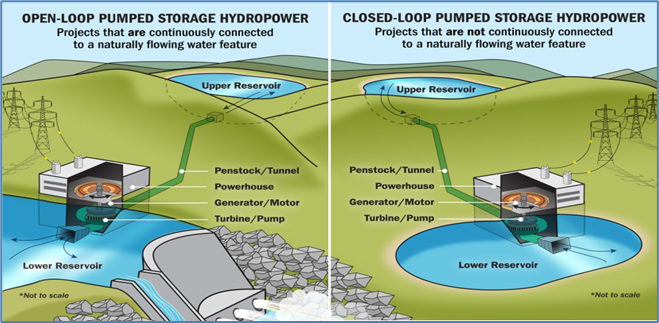Why in News?
The Union Environment Ministry’s expert panel has decided that it will not grant final clearances to pumped hydropower projects proposed in the Western Ghats region without site visits.
With the fragile ecology of the Western Ghats in mind, this will ascertain the impact of such projects on the environment.
What’s in Today’s Article?
- What is the Pumped Hydropower Project?
- PSH Projects in India
- Concerns Regarding PSPs in Western Ghats
What is the Pumped Hydropower Project?
- About:
- Pumped hydropower projects, also known as pumped storage hydropower (PSH) projects, are large-scale energy storage systems that use water to generate and store electricity.
- It is the most dominant form of energy storage on the electric grid today.
- Working:
- It is a configuration of two water reservoirs at different elevations that can generate power as water moves down from one to the other (discharge), passing through a turbine.
- The system also requires power as it pumps water back into the upper reservoir (recharge).
- PSH acts similarly to a giant battery, because it can store power and then release it when needed.
- Types:

- Open-loop PSH systems connect a reservoir to a naturally flowing water feature via a tunnel, using a turbine/pump and generator/motor to move water and create electricity.
- Closed-loop PSH systems connect two reservoirs without flowing water features via a tunnel, using a turbine/pump and generator/motor to move water and create electricity.
- Benefits:
- Grid stability: PSH projects help balance the grid during periods of high demand or low supply.
- Renewable energy integration: PSH projects help integrate renewable energy sources into the grid.
- Challenges: High start-up cost; meticulous design and planning; environmental and regulatory constraints, etc.
PSH Projects in India:
- The Central government has pushed for the expansion of pumped storage project’s (PSPs) capacities to plug the variability of solar and wind energy in the electricity grid.
- The Central Electricity Authority of India (CEA) has estimated the on-river pumped storage hydro potential in India to be about 103 GW.
- The Ministry of Environment, Forest, and Climate Change (MoEFCC) has recently given the environment-related go-ahead to pumped storage hydropower projects with a capacity of 11.98 gigawatts (Gw).
- The Expert Appraisal Committee (EAC) on River Valley and Hydroelectric Projects (one of the 11 sectoral panels that grant prior environmental permissions) gave approval to the -
- Greenko Energy’s 3.66 Gw project in UP’s Sonbhadra district, which is the largest project to receive an environment clearance recommendation.
- Two projects with capacities of 1.2 Gw each, belonging to Sterlite Grid and Gandhwani Energy in Chhattisgarh, received recommendations.
- One project of Oju Subansiri Hydro Power Corporation of 2.22 Gw for Arunachal Pradesh and one project of JSW Energy of 1.5 Gw for Maharashtra were also given the nod.
- This marks the largest tranche of these new-tech energy storage projects to be approved in one go in the country.
Concerns Regarding PSPs in Western Ghats:
- The EAC on river valley and hydroelectric projects noted that the MoEFCC had granted terms of reference (ToR) or preliminary permissions to 15 PSPs in the Western Ghats.
- The preliminary permissions spell out the scope of the environmental impact assessment studies that are to be carried out for mandatory public hearings before the projects are considered for final environmental clearance.
- Some of these PSPs fall in villages identified as eco-sensitive areas in the government’s draft notification on the protection of the Western Ghats.
- As these projects may adversely affect the biodiversity and forests in the fragile Western Ghats, the EAC decided that site visits should be carried out to ensure thorough scrutiny.










